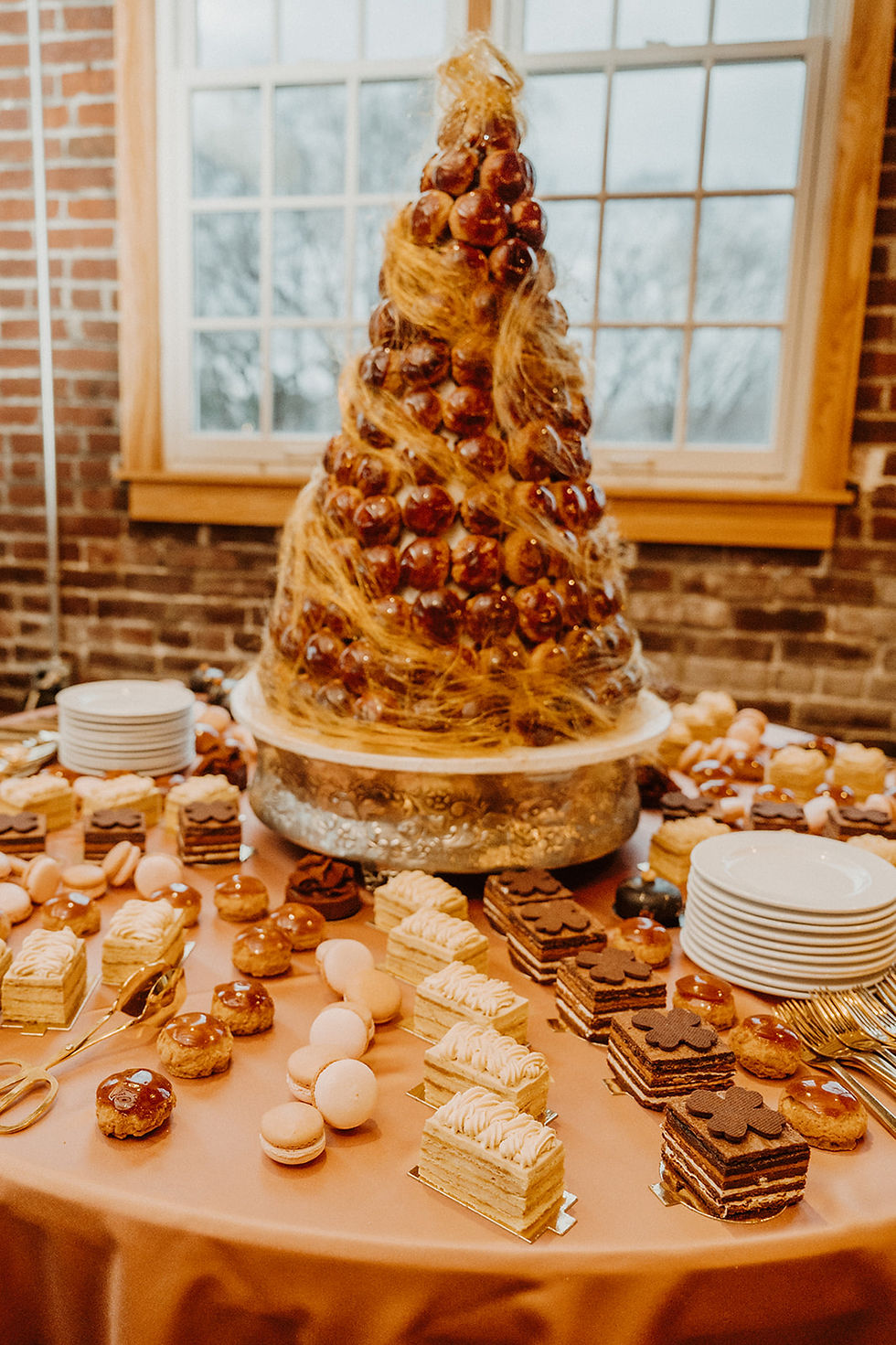Wedding Cake History | Wedding Planner | Wedding Traditions
- Elizabeth Craney

- Jul 13, 2023
- 4 min read
In the world of weddings, whether you're a guest or the one walking down the aisle, the topic of wedding cake comes with A LOT of opinions. Fondant or icing? Chocolate or Vanilla? Naked or frosted, flowered, and dressed to the nines? And, for many, the question is to cake or not to cake? While we can't settle the debate of cake versus pie, we can share a little bit of the history of wedding cake and how it became a symbol of weddings worldwide.

Do As the Romans Do
As with many modern traditions, wedding cakes can be traced back to ancient Rome and Greece. While their version of the wedding cake was a far cry from what we know today, and a bit more in line with a loaf of bread, the idea was there. During ancient times, wheat was a symbol of prosperity and fertility. In an effort to encourage fertility for the bride, the ancient Greeks and Romans would throw wheat at the couple, and as the tradition progressed wheat would be baked into bread. For a time, grooms would smash the bread over their bride's head as both an assertion of male dominance and a sign of her fertility, a tradition that has (thankfully) gone by the wayside. Though, a little smash of the cake in one another's faces by the happy couple isn't too far from its ancient roots!
From its earliest iteration, as wheat being thrown at the bride, to being baked into bread, ancient Roman and Greek traditions got even closer to what we now know as wedding cake. As a sign of just how prosperous a family was, one baked item become two, became, three, until suddenly the tradition of stacking wheat cakes became popular. While they wouldn't have been elaborately decorated in the way we know today, this first stack of cakes was the basis for multi-tiered cakes as we know them.

Positively Medieval
From the Middle Ages to the time of Shakespeare wedding cakes crept a bit closer to the bakes we know today. As access to ingredients like sugar, fruits, and spices became more readily available the basic wheat cakes of antiquity got a little tastier! According to the experts at Brides, it became customary for a bride's friends to bring her sweet buns on her wedding day. The more buns received, the more popular the bride was, and before long honey and applesauce were brought in to help keep the buns together as they were stacked to new heights! A first taste of "frosting," in some ways. Brides and grooms of the middle ages would share a kiss over their tower of sweet buns, much like couples do today after indulging in their first bite of cake together.

Victorian Extravagance
By the time Queen Victoria broke tradition and proposed to her beloved Albert (in a love story for the ages), cakes were about to make huge leaps. So huge in fact, that by the time all was said and done, Queen Victoria's wedding cake weighed in at 300 pounds. The cake was made of "three tiers of English plum cake that stood 14 inches tall, measured nearly 10 feet across." In addition to its groundbreaking size, the cake was decorated ornately and covered in pure white royal icing. During that time, refined sugar was so expensive that to get a pure white icing was the ultimate sign of status. This became a huge trend among the elite class, and it also served as a symbolic nod to the bride's purity.
With the groundwork set for truly remarkable royal cakes, decades later Queen Elizabeth went even larger. With a 500-pound cake when she wed Prince Philip in 1947, Lizzie ensured the place of extravagant cakes in the zeitgeist. Leaning into royal trends has been popular for ages, meaning the opulently adorned, frosted, and flowered bakes of the Monarchs soon began to trickle into the weddings of commoners.

The Cake As We Know It
In the decades since Queen Victoria changed the tides of wedding cakes, they have gone down many paths. For many years, classically decorated cakes were seen at nearly every wedding. White cakes, with tiers, icing embellishments, and toppers were the objective, with some customizations within those confines. As couples began breaking from tradition in all areas of wedding planning, so too did their choice of cakes (or lack thereof!). The most distinguishing factor of modern weddings is that couples do what they love, versus doing what is expected. Couples who hate thick layers of fondant and sickeningly sweet icing leave it on the cutting room floor and instead opt for naked cakes. Cake-hating couples go all out for pies, dessert bars, and towers of elegant pastries. Making wedding day selections from start to finish that feel distinctly like the couple themselves has replaced the years of conforming to specific styles just because they're the "norm."

Cutting the Cake
Of course, the cake alone isn't the highlight of weddings worldwide! There's also the ever-so-important element of cutting the cake. We have the Victorian era to thank for this tradition as well. During a time when brides would be responsible for cutting the cake alone, it was then referred to as the "bride's cake." This tradition morphed into what we now see in 77% of weddings - the cake-cutting ceremony. This moment is symbolic and important as it is the first joint task the duo will do as a couple - a display of unity, support, and collaboration that will set the stage for a lifetime of partnership.
Ancient Roman and Greek wedding wheat bread walked, so statement cakes with geodes, dripping colors, and pressed flowers (just to name a few) could run. These days, whether you opt for a loaded (cake-free) dessert bar, a Queen Victoria-inspired mega cake, or a naked cake, the sky is the limit as far as wedding desserts go. As with so many wedding traditions, historical roots have paved the way for modern traditions.
Did you find this helpful? Here are more guides you might love!
Photos:
Sources:














































Comments